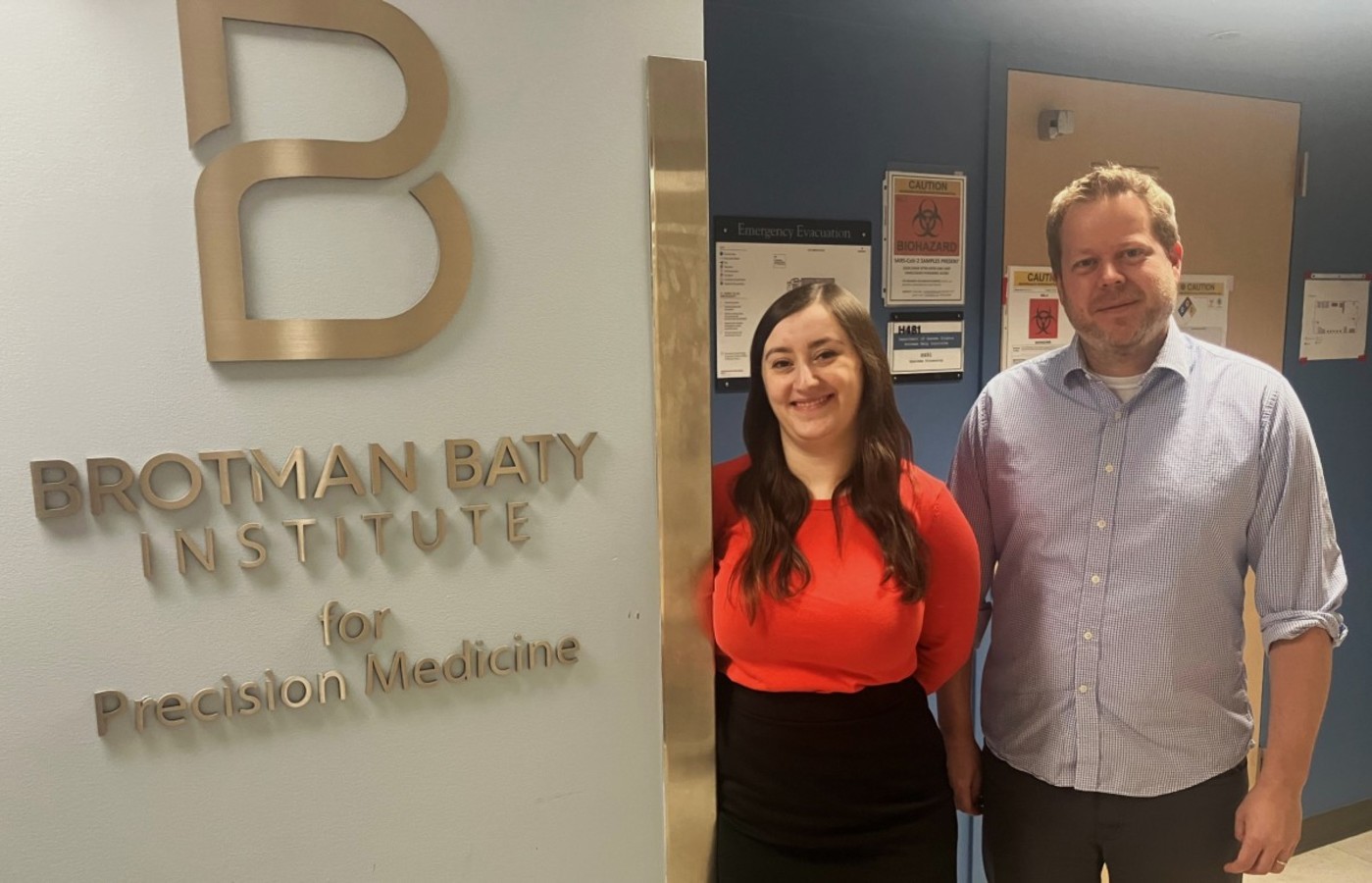 Sophia Gibson (left) and Dr. Danny Miller 'I was very impressed by her prior lab experience and how she had clear outcomes from each lab she had been a part of,' Miller said.
Sophia Gibson (left) and Dr. Danny Miller 'I was very impressed by her prior lab experience and how she had clear outcomes from each lab she had been a part of,' Miller said.
Many high school graduates planning a career in genetics typically consider prospective colleges with extensive science curricula. But Sophia Gibson took a different path. Her diverse interests – from dance to Shakespeare to Harry Potter – led her to Bryn Mawr, the small women’s liberal arts college near Philadelphia.
“I could do everything here,” she said. “There were excellent film classes, a beautiful dance studio, and the buildings looked like Hogwarts.”
Gibson may not have known when she arrived in 2016 as a freshman that, according to its website, “Students come to Bryn Mawr in search of academic excellence and an education that enables them to turn their passion for learning into a life of purpose.”
For Gibson, like many students, that life purpose has been an evolution. After graduating magna cum laude with honors with a Bachelor of Arts in Biochemistry and Molecular Biology, she started a two-year project as a research technician at Northwestern University’s Department of Molecular Biosciences.
Her undergraduate advisor Dr. Joshua Shapiro recommended Gibson to his colleague Dr. Erik Andersen at Northwestern. Before her interview with Andersen ended, she was offered the position.
“It was the best opportunity,” Gibson said. “The position was lab-based, and taught me many of the fundamentals of genetic research. I was able to design my own projects, conducted research, both computational and wet lab-based work.”
Moreover, the work led to a micropublication and her first peer-reviewed full-length paper as the first author on “Benzimidazoles cause lethality by inhibiting the function of Caenorhabditis elegans neuronal beta-tubulin” for the International Journal of Parasitology: Drugs and Drug Resistance.
More importantly, Gibson said, those two years at Northwestern, “refined my goals for graduate school.”
Today, she is actively working towards those goals in the long-read sequencing lab of BBI’s Dr. Danny Miller, who, along with Dr. Lea Starita, are advising Gibson as she pursues a Ph.D. in Genome Sciences.
Starita called Gibson “tenacious,” and noted: “She probes difficult genetics questions from all sides and does not stop exploring possible answers until she’s confident she’s right. “
Miller said Gibson’s lab background has provided a foundation for her accomplishments.
'One of (Sophia's) biggest contributions has been the development of methods to identify repeat expansions in long-read sequencing data and ways to visualize those results.' Dr. Danny Miller
“When I first met Sophia, I was very impressed by her prior lab experience and how she had clear outcomes from each lab she had been a part of,” said Miller. “She has contributed in several ways to our research. One of the biggest contributions has been the development of methods to identify repeat expansions in long-read sequencing data and ways to visualize those results.”
Gibson chose the University of Washington for reasons both personal and professional: a much milder climate compared to her hometown of Chicago and the foregoing of owning a car because of extensive public transportation.
“The Department of Genome Sciences included genetics, bio-organism studies, and applications to understand disease development and computational biology,” said Gibson, 25. “Those, combined with an overwhelming sense of collaboration among the students and faculty, clearly made the UW the best choice.”
Among other work, that “best choice” has enabled Gibson to:
-
Develop custom pipelines and web applications for analyzing methylation patterns and repeat expansion size variation for 1000 genomes using Oxford Nanopore Technologies Sequencing Consortium data; and
-
Evaluate the potential of long-read data for explaining X chromosome linked disorder phenotypes in 46,XX individuals.
“The advancements of long-read sequencing technology allows us to look at structural variation and modifications in DNA at a level of resolution never before available,” Gibson said. “Since the completion of the Human Genome project, we have much more data to identify potential disease mechanisms.”
She expects to complete her Ph.D. in four years, then begin working as research scientist in academia or industry.
“I want to be in the computational space,” she said. “But I am not planning to leave the bench behind.”
Miller believes Gibson should not rule out potential opportunities in the classroom.
“She’s made a big impact in the lab by teaching others how to do some really interesting things in R, the programming language,” he said. “It’s clear she’s very good at teaching others, is patient when teaching, and seems to genuinely enjoy it. This is a characteristic that is very hard to teach, and something I think will serve her well in the future.”


